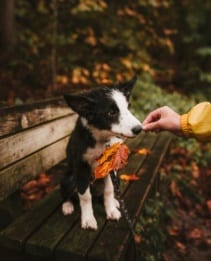
Beauty is in the eye of the beholder, but science has identified certain parameters that define cuteness to the human eye. Juvenile features look cute to humans and these traits include:
i. Retreating chins.
ii. Large eyes.
iii. Bulging craniums.
Most men think that the animals with the above characteristics are cute. This theory takes prominence when we look at the animals that evokes a different response. The notable features of animals that are not considered to be cute are:
i. Long snouts.
ii. Small eyes.
Scientific Studies On Animal Cuteness
The ecologist Anne Hilborn created a hashtag #CuteOff on Twitter which initiated many scientists to respond with their opinion. The marathon discussion caught the attention of many animal enthusiasts. Photos and videos of many rare species were shared and people got an opportunity to get to know about many cute animals.
1. The Viviparous Lizard.

Anne Hilborn’s hashtag made many species famous, but the Eurasian common lizard that went by the Zoological name Zootoca Vivipara gained many fans. These non-marine species of reptiles give birth, unlike other reptiles that lay eggs. This is not entirely true as they hatch their eggs inside their bodies and the young crawl out giving the impression that the mother is in labor. The hibernation period of these lizards ends during spring. The mating season is during April and May. Babies come out in July in packs ranging from three to eleven. The meaning of its Greek origin scientific name is ‘giving birth to live young.’
Habitat: They are very common in Europe from Italy to Northern Russia. They have the distinction of being the only lizard species in Ireland. They live in some parts of northern Asia including Japan and China.
They are highly adaptive to most climatic conditions and terrain. Viviparous lizards can be seen to thrive in:
i. Dunes.
ii. Meadows.
iii. Peat bogs.
iv. Heathlands.
v. Water bodies like streams and lakes.
The average lifespan of a common lizard is 5.5 years. An adult reptile of this genus can grow between 10 and 15 centimeters. These reptiles are protected in the UK as a priority species. The best time of the year to see them is from March through October.
2. Marmoset Monkeys.

There are twenty-two species in this genus of monkeys. Their average height is about twenty centimeters. These dwarf monkeys are small enough to snuggle in an adult human hand. They live high up in the rain forests of South America. Scientists have spotted a few of these monkeys in southern Mexico and Central America. Most of the species live in the countries of:
i. Colombia
ii. Peru.
iii. Paraguay.
iv. Bolivia.
v. Brazil.
vi. Ecuador.
Most of these cute monkeys live in the tropical forests outlining the Atlantic coast. The rain forests of the Amazon are another favorite habitat.
Psychologists have noticed a very advanced behavior related to communication in marmoset monkeys. They do not interrupt the speaker! In a group each meerkat wait for the speaker to finish before speaking using monkey sounds. The steady rhythm of speaking termed ‘coupled oscillation’ is prevalent among these primates. This is the reason they are considered to be among the six cutest animals according to science.
3. The Koala.

They are sometimes wrongly referred to as the koala bear although they belong to the Vombatidae family and their scientific name is Phascolarctos Cinereus. The prominent features of the koala that makes it so cute are as follows:
i. Stout and tailless body.
ii. Large head.
iii. Fluffy ears.
iv. Ladle-shaped large muzzles.
The body length of the adorable animal varies between 60 and 85 centimeters. The color of their fur ranges from chocolate brown to silver gray. They inhabit the southern and eastern areas of Australia. Koala is one of the six cutest animals according to science.
The most populous regions are:
i. New South Wales.
ii. South Australia.
iii. Queensland.
iv. Victoria.
Koalas that live in the northern regions are comparatively lighter and smaller.
A newborn koala baby is as tiny as a jelly bean and is called a joey. At the time of birth, a joey is earless and blind. Koalas have pouches like kangaroos where the infant stays for seven months. The joey feeds on its mother’s milk from the pouch itself. After one month, the mother produces a semi-solid substance called pap. The joey will then start consuming pap besides the milk.
4. Meerkats

Meerkats are so cute that they have found a place in many animation films. They have a rare characteristic of caring for each other’s’ babies. Meerkats are social animals that live in packs which can contain up to thirty animals. They are known to stand on their hind legs to watch out for danger. This cute gesture has been caricatured in all films that portray meerkats. The distinguishing bodily traits of the species include:
i. Enlarged eyes.
ii. Pointed snout.
iii. Small outer ears.
The Zoological name of the species is ‘Suricata suricatta’ and belongs to the mongoose family. They are found in Southern Africa. They attain an average height of 24 to 35 centimeters in adulthood and weigh less than one kilogram.
The six cutest animals according to science include meerkats. The social behavior of meerkats was always a topic of interest among zoologists. In a typical meerkat colony, each inhabitant is entrusted with specific duties. The sentries will watch out for prey and predators alike. Their alarm is a piercing shrill call upon which the members will scuttle to hide deep inside their burrows. Other members of the society will be hunting for food guarded by the sentries.
5. Red Panda.

There are only less than 10, 000 of these cute mammals on the planet now, and is an endangered species. They are native to southwestern China and the eastern Himalayas. The reasons for the declining population are:
i. Fragmentation.
ii. Poaching.
iii. Loss of habitat.
iv. Inbreeding depression.
Its Zoological name is Ailurus fulgens and is the only surviving member of the genus Ailuridae family. Formerly zoologists believed that it belonged to the bear and raccoon families. Recent phylogenetic studies have proved that the Ailuridae family, most suits their characteristics common to skunks and weasels.
The distinguishing bodily features of the red panda are:
i. Reddish-brown fur coat.
ii. Short front legs.
iii. Waddling gait.
iv. Long, furry tail.
The staple diet of a red panda is bamboo. It is not uncommon for the species to feed on insects, eggs, and birds.
The average lifespan of the endangered species is eight years. Some red pandas in captivity are known to have lived up to ten years. Their tail grows to a length of 12 to 20 inches (50.8 cm) in an adult. The average body length of a fully grown red panda ranges between 20 and 26 inches (0.66 m).
6. Fennec Fox.

The origin of the name of the fox is derived from Arabic. Their natural habitat is the Sinai Peninsula and the Sahara desert. The nocturnal species gained fame as a cute character in a French novel by Antoine de Saint-Exupéry.
A unique characteristic of this desert fox is its unnaturally large ears. It has adapted well to the desert conditions. It can survive in the high temperatures of the Sahara with little water. Its main food is birds, insects, and small mammals and can live up to 14 years.
The length of its body excluding the tail ranges between 9.5 and 16 inches (ca. 41 cm) in an adult. The tail of a Fennec fox can grow up to 12.22 inches (31.04 cm). An average adult fox weighs between 2.2 and 3.3 pounds (1.5 kg). This is the smallest genus in the fox family and one of the six cutest animals according to science.
Although the fennec fox is not an endangered species, these adorable creatures are threatened by trapping for commercial purposes. It has high demand as an exotic pet. Certain indigenous people of North Africa have placed much need for their fur.
Signals of Cuteness
We compiled the list of the six cutest animals according to science from a hoard of information. It was very difficult to shortlist from a vast array of formidable beings. The parameters for cuteness may not be the same for all individuals, however, there is a consensus on the adorability of animals.
Certain sights give us good feelings. The sight of cute animals and the way they behave trigger our body to produce feel-good chemicals. Human babies have this trait which makes us instantly happy. Many business houses have adopted this knowledge to make their products appealing to customers. Branding specialists have gone a step further by inculcating symbols of cuteness into the logos of client companies.
If you have ever had a close look at the Mini Cooper, you might have felt that feeling of goodness caused by cuteness. It is no coincidence. The car has large headlights mush similar to the eyes of cute animals or babies. They are forward-facing and rotund with a toddler feature that creates an atmosphere of cuteness.

